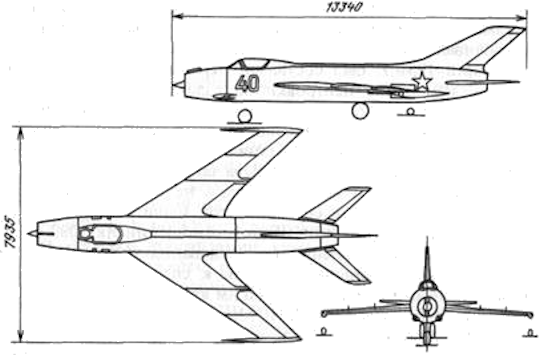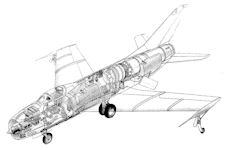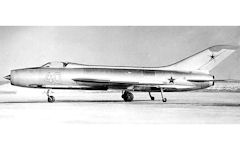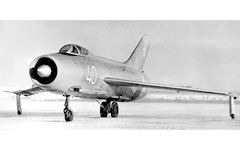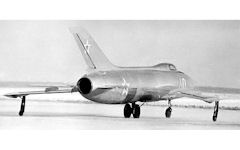Yak-140 experimental fighter
The Yak-140 was an experimental fighter developed in Yakovlev Design Bureau. Created in the mid-1950s, the Yak-140 remained a mystery until recently both for the West and for domestic aviation historians. This is not surprising, because the aircraft not only did not participate in the air parades that were held at that time regularly, but never even rose into the air, although it was built and jogged along the aerodrome in Zhukovsky. An additional interest in the Yak-140 is the fact that this light front-line fighter could well compete with the widely known MiG-21.
The main intention of the Yak-140 creators was clearly defined in the draft design - the first official document submitted to higher authorities in July 1953. It said, in part: "The current outline design of the front-line fighter with the AM-11 engine is a further development of the proposed fighter, which successfully combines the parameters of a small-sized light aircraft and provides outstanding combat and combat qualities, ... Flight data: speed near the ground 200 m / s and at an altitude of 15,000 m - 30 m / s. ceiling of greater than 18,000 m in altitude of 10000-15000 m maximum speed reaches 1,700 km / h."
In the course of preliminary searches, the Yak-140 designers studied several alternative variants of the power plant, including VK-3, TRD-I, AM-11. The best results were obtained with a lighter AM-11, which had very high specific parameters at that time and later became one of the most successful Soviet aircraft engines (serially produced under the designation P-11, was mounted on the MiG-21, Yak-28).
The time when the Yak-140 was designed was characterized by very dynamic development of combat aviation, and the speed of flight became extremely important. Rapid progress in the field of aerodynamics and aircraft engine building opened up prospects which until recently had seemed fantastic. In just 5-6 years, the speed of fighters increased almost twofold, and in many ways this pursuit of speed was at the expense of maneuverability. Representations of airmen about the air battle underwent major changes, which was largely facilitated by the emergence of guided air-to-air missile weapons. The most striking example is the Lockheed F-104 Starfighter.
The designers Yak-140 went the other way. They deliberately sacrificed speed for the sake of good maneuverability. For this, the Yak-140 wing was made somewhat larger than for high-speed aircraft of this class. At the same time, the maximum speed was reduced by 150-200 km / h, but maneuverability and takeoff and landing characteristics were significantly improved. The low values of the specific load on the wing (at take-off of 250 kg / m2 and at the landing of 180 kg / m2) and low wheel pressure on the ground (6.0 kg / cm2) allowed the operation of the aircraft from ground airfields. In addition, the vertical descent rate was significantly reduced and thus the landing of a fighter with a stopped engine was facilitated.
The Yak-140 was supposed to have a thrust-weight ratio [tyagovoruzhennostyu] was was phenomenal for its time, which was calculated to be slightly more than 1. This corresponds to the performance of modern fighters F-15, F-16, MiG-29 or Su-27. For comparison: this index for MiG-21F (1958) was 0.84, and for F-104A it was 0.83. Such thrust-weight ratio combined with a relatively low specific load on the wing would provide the Yak-140 an absolute advantage in maneuverable air combat. It is significant that modern fighters, designed to gain superiority in the air, are given priority in these qualities.
When designing the Yak-140, perhaps, no less attention than the flight characteristics, was given to the manufacturability of its mass production, simplicity and convenience in operation. The design of the main aggregates and their division on the panel were carried out in such a way that the possibility of a stream assembly was provided. Stamping and casting were widely used. The adopted layout of equipment and weapons, as well as large hatches in the fuselage made it easier to operate. Wiring control of the rudders and the engine, as well as a significant part of the wiring housed under the easily folding gargrot. To replace the engine, the tail of the fuselage was undocked. The design and layout of the Yak-140 were performed taking into account the experience,
The Yak-140 (according to the project in 1953) had a free-bearing all-metal mid-plan semi-monocoque design with a working skins, swept wings and feathers. The wing consisted of two separate consoles, resting on a powerful fuselage beam. Its power set consisted of two spars and ribs, located perpendicular to the front spar. The sweep of the wing along the line of quarters of chords was 55.5°. The relative thickness of the root profile is 6.3%, the terminal thickness is 8%. The transverse V wing was -4.5°. The wing was equipped with retractable flaps and ailerons with weight compensation. Two aerodynamic ridges were mounted on the top surface of each console.
In the forward part of the fuselage was the nose cone, in which there were aggregates of a radio range-finder. Fuel (1275 kg) was located in the tanks located behind the cockpit and in the tail of the fuselage. The cockpit is airtight, with an ejection seat. In case of an emergency reset of the lantern, air brakes were automatically opened on the sides of the tail of the fuselage, which increased the safety of the bailout. The fighter's armament consisted of three 30-mm cannons with ammunition of 50 rounds per barrel and 16 unguided PC caliber 57 mm.
The bicycle-type chassis consisted of a main, front and two underwing supports. Amortization is air-oil, the design of all the racks is lever. The main support was equipped with two brake wheels 600x200 mm, and the front one - hydraulically controlled wheel 480x200 mm. Underwing supports with wheels 250x110 mm retracted into fairings located at the ends of the wing. LDPE was installed on the same fairings. Cleaning and release of the chassis were carried out using a hydraulic system (emergency release - pneumohydraulic). The launch of the front and main landing gear of the chassis occurred along the flow, which guaranteed their release even at low pressure in the system.
In 1953, the Soviet Union began to implement the program to create a new generation of fighters, distinguished by a high supersonic speed. In the design office of AS Yakovlev and AI Mikoyan, when creating such aircraft, they relied on the engine AA Mikulina AM-11, and at the firm "PO Sukhoi - a much more powerful and, naturally, heavy engine AL-7. Actually, AM-11 and AL-7 in 1953-54. they did not exist, they were developed in parallel with the aircraft. However, the pace of work on Yak and MiG fighter jets was higher than for the AM-11 engine. Then in both KB decided to build experimental models of machines for the serial engine of lower power AM-9B (thrust at afterburner 3300 kg) or its modification AM-9D.
The Yak-140 with AM-9D was completely similar to the main version with AM-11. The only difference was in the elements associated with the power plant, and in the armament, which consisted of two 23 mm HP-23 guns. The radio-range-meter was not set. It is clear that this fighter did not plan to receive the declared flight data. It was intended for working out and development of systems and units, revealing of features of management that would accelerate commissioning of the basic variant of the machine.
This experimental fighter was built at the end of 1954. In January 1955, its ground tests began: taxiing, jogging to the speed of takeoff, etc. Meanwhile, TsAGI conducted a statistical test of the main variant of the Yak-140. It turned out that the wing of the aircraft needed to be strengthened, but this did not in the least interfere with the first stage of flight tests. Nevertheless, in February 1955 the work on the plane was stopped literally on the eve of the first flight and was no longer being renewed. A satisfactory explanation of this fact has not been found so far, we can only state that there was no official decision of the MAP to curtail the work on the Yak-140. The need to refine the wing can not be considered a serious reason for abandoning the aircraft, As such cases are often met before. Technical problems that arose in this case were solved, as a rule, quickly and quite successfully.
The Minister of Aviation Industry of the USSR, P.V. Dementiev, without any explanation, informed him of the hopelessness and unreasonableness of the attempts of the KB to continue work on the Yak -140, because preference will still be given to another aircraft. Yakovlev, well aware that without the support of the leadership of the MAP, the CB was not able to succeed, ordered to stop all work on this aircraft. So, in February 1955, the Yak-140 was finished, and since then Yakovlev's KB has never returned to light front fighters.
|
NEWSLETTER
|
| Join the GlobalSecurity.org mailing list |
|
|
|


